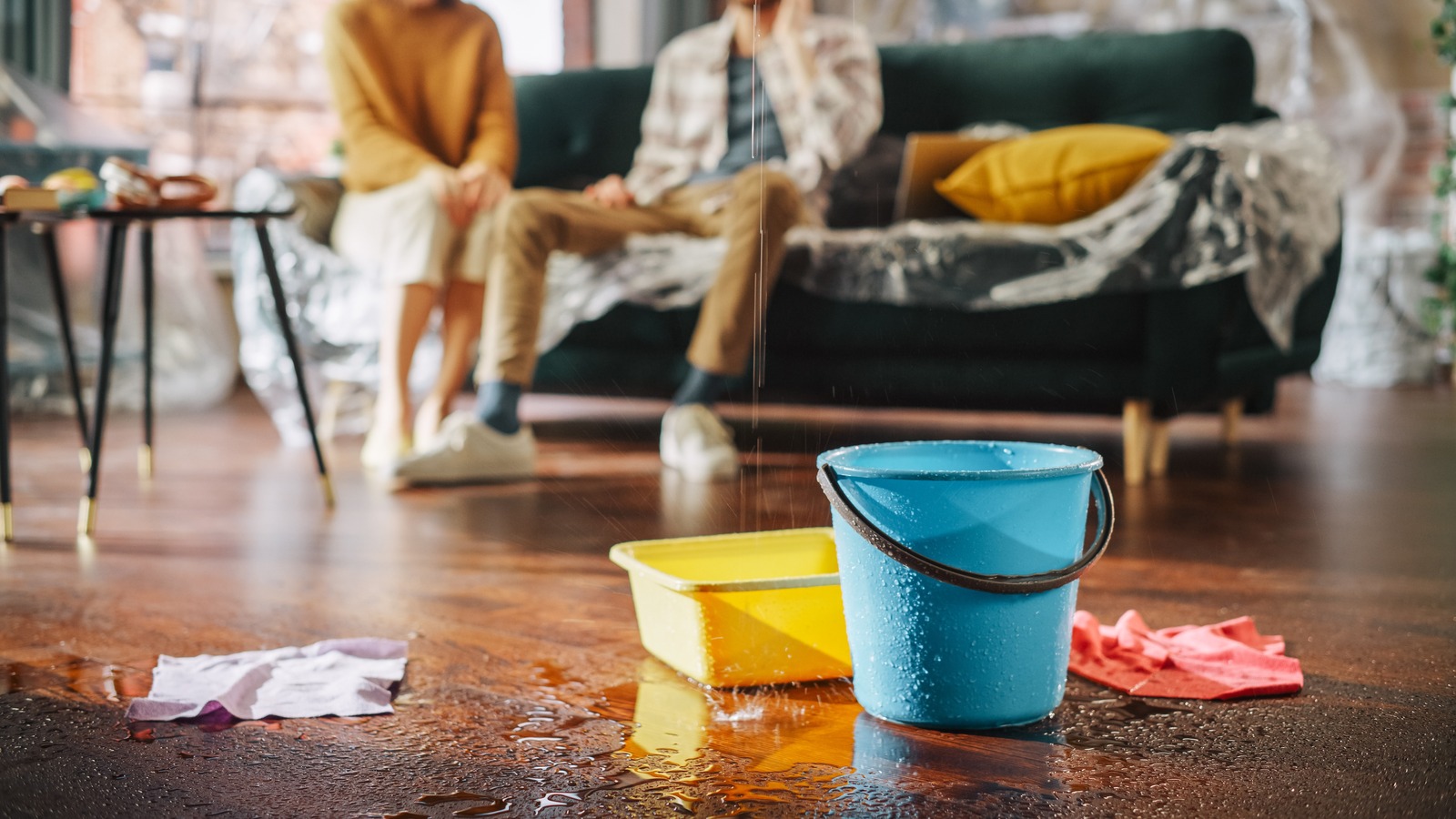
Waiting To Fix A Leaky Pipe Is Never The Right Choice For These Reasons – House Digest
Water, especially water under pressure, has a habit of finding its way into places we don’t want it to be. And however innocuous water seems in a half-full glass, it’s certainly not harmless when it escapes from your home’s plumbing. There are three sorts of things you can expect to deal with when a water pipe leaks: mold, structural damage, and declining property value. Any pipe leaks will cause some amount of damage, and even that smallest of leaks can cause catastrophic damage. The difference between a quick afternoon cleanup and a major repair and remediation project usually depends mostly on one key factor: how quickly you act.
A massive leak might put a gallon of water on your bathroom floor if you catch it soon enough, and you can often clean it up with a mop. A tiny leak that seems like no big deal can soak hundreds of gallons of water into your walls, ceilings, and floors, and you’ll need a plumber, a construction crew, and perhaps a mold remediation team to deal with it. All this and more is why it’s extremely important to track down your leak and deal with it as promptly as possible.
Mold is a major concern
 Mflo786/Shutterstock
Mflo786/Shutterstock
Mold is one of the two most common and severe problems created when leaky pipes are left unfixed. Mold is already in the air everywhere; it’s a lack of moisture that prevents it from taking hold, reproducing, and becoming a problem. There are many kinds of mold — including mildew — in the environment, and their “purpose” is to break down organic materials such as downed trees and fallen leaves. Unfortunately, they can’t distinguish between fallen trees and your wall studs and wall coverings, but because your walls are usually dry, they cannot actually break them down. However, moisture will kick-start this decomposition process, and a pipe leak is one sure way to introduce moisture where you don’t want it.
Once mold gets a foothold, it can cause not only major home damage, but also health problems ranging from minor annoyances to life-threatening illness. People sensitive to mold may have typical allergic reactions, like a runny nose or red, itchy eyes, and they might be accustomed to experiencing this in environments where mold thrives. These symptoms can become severe and new health problems may develop if mold is left unchecked. Mold can present dangerous issues for people with respiratory problems like asthma, and can cause asthma to develop in some circumstances. Many people worry about “black mold” and its many reported health concerns, but the CDC says all molds can lead to the proven problems, and should be removed from buildings.
Wood decomposition is even more alarming
 Valmedia/Shutterstock
Valmedia/Shutterstock
The second common major problem caused by water leaks is structural damage brought on by wood rot. Left uncorrected long enough, a water leak will almost certainly make the structural lumber in your walls begin to decompose. Given enough time with consistent access to moisture, wet rot leads wood to soften and eventually fail to accomplish its mission of holding things together or holding things up. The next step after rot is collapse. Mold is the major cause of wood decay, so health concerns aren’t the only problems you get with a pipe leak or other water intrusion. (One type of mold, Serpula lacrymans, can cause “dry rot” in structural lumber without requiring any water except what’s already in the wood, but this is comparatively uncommon.) Of course, leaking pipes aren’t the only cause of wet rot in wood, so if you’re experiencing this kind of decomposition, be sure to look for all potential problems.
Wet rot presents itself in different ways based on the wood that it’s affecting. Some species of wood might have a whitish appearance when infected with mold, while others might look more brown. Sure signs of trouble include softened or crumbly wood, shrinkage, visible mold growth, and a musty smell. Poking around with a screwdriver is a good way to find soft, decaying wood. Mold growth can usually be arrested by eliminating the water source — by, for example, fixing a pipe leak — but treatment with fungicides is often a good idea.
Plus even further consequences, including disintegrating drywall, wallpaper, and more
 Flrwnx/Shutterstock
Flrwnx/Shutterstock
It turns out that most of the signs that tip you off to a water leak are, themselves, damage to your home. You’ll often find that water intrusion affects surfaces and components of your home that aren’t structural, but the damage can be severe and it can spread to structural lumber, so it must be dealt with. Some sources of water, such as leaky windows or improperly-sealed roof penetration, have nothing to do with leaking pipes, so use your best judgment when assessing your issues. For example, a rotting window sill is likely to involve a leaking window, not a leaking pipe. Pipe leaks are more likely to cause visible damage to drywall and other wall coverings. Look for damage like stains, warping, or swelling of walls; moldy or decaying baseboards; and peeling paint or wallpaper. Your eyes and a screwdriver are often enough to diagnose a water intrusion problem, but you can also use a moisture meter and an infrared camera to good effect.
Stained surfaces will need to be sealed and painted, at least. Damaged surfaces often need to be completely replaced. Removing affected wall coverings is often necessary to repair a leaking pipe, and is usually a good idea anyway because you’ll want to inspect the area for other damage. The key to a successful repair is to both fix the consequences of your leak and to correct the cause. A pipe that continues to leak will continue to cause decay and, eventually, structural and health problems.
You can expect some floor damage
 Jatuporn Chainiramitkul/Shutterstock
Jatuporn Chainiramitkul/Shutterstock
Because water has a tendency to pool, floors and subfloors are where you’ll see the quickest severe damage to your home. And, therefore, floor damage is one of the reasons you can simply never let a leaking pipe go unrepaired. Look for buckled floors or subfloors, cupped boards, loose tiles, or wavy flooring. Your beautiful hardwood floors can mold and start to buckle if exposed to a constant source of water — and a pipe leak is usually the most constant source of water you can have.
Of course, the ceiling of the floor below you will also catch some of that leaking water, so you’ll find ceiling damage for the same reasons. Like a subfloor, ceiling materials (like drywall) tend to absorb water, causing them to pull away from their framing and, eventually, fall. Many of us have seen enough water damage on ceilings — the stray puddle-shaped outline — to have gotten somewhat numb to it. But a new water stain is a cause for major alarm, because on the other side of that discoloration could be many gallons of standing water waiting to find their way down the next floor. Damaged floors, subfloors, and ceilings will almost always have to be replaced, and in the case of ceilings, it’s often necessary to remove the gypsum board in order to assess and fix the leak.
Insects are attracted to moisture
 koonsiri boonnak/Shutterstock
koonsiri boonnak/Shutterstock
Bugs won’t generally move into a completely dry environment any more than you’re likely to book a hotel room in a building without running water. But once they do move in, they can be difficult to get rid of. The more unpleasant the insect or other crawling pest, it seems, the more likely it is to be attracted to water in your home. Common moisture-seekers include cockroaches, termites, mosquitoes, silverfish, earwigs, centipedes, ants, and some spiders. Even the humble and harmless cricket can be a sign of unwanted water.
You might be tempted to focus on eliminating the bugs themselves when you discover them, but stop and consider the fact that many of these pests are attracted to water, and some will not exist where moisture does not. They are a potential sign that you need to be looking for water intrusion, including perhaps a leaky pipe. You’re probably going to have a tough time eliminating the bugs without first eliminating the water they seek.
Mice like water, too
 Torook/Shutterstock
Torook/Shutterstock
Like unwelcome insects, mice are naturally drawn to sources of water. And mice have an unfortunate habit of chewing on important things, to say nothing of the damage they can do just to get into your home in the first place. Depending on where you live and the age of your home, you might reasonably expect to have an issue with mice at some point. Should you care? After all, they have such an agreeable air about them that even articles raising the alert, like this one from Pest World, can sometimes describe them in cutesy language like “little gymnasts.” Unfortunately, such phrases translate into realities like “they will climb all over the inside of your walls and destroy wiring and insulation,” as well as, “they will eat your food and leave urine and feces behind everywhere.” Cute!
More than one in six of the U.S.’s 123.6 million households are said to have mice, and every one of those is prone to carrying disease, destroying property, and consuming your food. They will repurpose your insulation to suit their own needs, and stick you with increased heating and cooling bills. And this could all be, at least in part, because they’ve found a place to live with a convenient, unintended water source: a simple, tiny pipe leak.
Fire, electrocution, and other issues can result from waiting
 Grigvovan/Shutterstock
Grigvovan/Shutterstock
Mice can certainly damage your home’s wiring, but leaks themselves are much more dangerous when it comes to electrical dangers. Failed circuits are common, and fires, electrocution, and other more dire problems are also major concerns. For example, since water tends to collect atop ceilings, the path of least resistance out of that space is often through light fixtures. That’s one of many ways electricity and water come into contact, and once that happens, a bunch of problems become possible.
Electrical short-circuits can cause electrocution or fire, though they are often handled well enough by a circuit breaker, but other problems can be more insidious. Corrosion of wiring and electrical fixtures can increase the resistance of the materials handling electricity, which raises their temperatures and creates a fire hazard. And the presence of water in just the right place can cause arcing, which creates very sudden and very strong increases in temperature which can easily lead to fire.
Mice chewing on wires can expose the conductors inside, leading to arcing and fire. If you have any inkling of rodent damage to your wiring, you should get it inspected by a licensed electrician, and you should install AFCI breakers wherever the damage could have happened. AFCI breakers are designed to detect arc faults and shut down a circuit that experiences any such runaway electricity. But they are not foolproof, and you must deal with leaks and any other causes of the arcing.
You can expect high water bills
 Evgenii Panov/Shutterstock
Evgenii Panov/Shutterstock
Even a tiny water leak can cause a massive amount of water use over time. Consider that a minor drip every 6 seconds can add up to a 500-gallon per year leak. And larger pipe leaks can be far worse, and as we’ll see, tend to get even worse over time. In fact, the average home is more likely to lose 10,000 gallons per year to leaks.
If the significant price tag associated with that doesn’t trouble you, consider the potential environmental costs in aggregate: U.S. homes’ water leaks can account for as much as 1 trillion gallons each year, according to the EPA. Further, a June 2023 report in Geophysical Research Letters (via American Geophysical Union) shows that human groundwater pumping has resulted in a substantial shift in the earth’s rotational axis and rising sea levels since 1993. Therefore, not only will fixing a leaky pipe save you money, but it’ll help save the environment too.
Leaks get worse over time
 Andrey_Popov/Shutterstock
Andrey_Popov/Shutterstock
Most types of pipes will leak even worse over time if a leak goes unaddressed. A crack in PVC or pinholes in copper can become a burst pipe. The mechanisms for this are simple: Corrosion can result from exposing a pipe to both moisture and air for long enough, which is exactly what a leak typically does. And a small leak can easily become a large one — slowly, or instantaneously — as the water pressure works its will against the weakened pipe. Corrosion can contribute to the expanding of the hole or crack, as well.
The best-case scenario here is a small leak that stays small and only leads to localized water damage, wood rot, and electrical problems. And when that small leak becomes a large one, or a burst pipe, then you find yourself dealing with flooding and many of the same issues — but exponentially worse. There’s no clearer case for not waiting to fix a leaking pipe, no matter how small the problem appears at first.
Repair bills get higher, too
 Skynesher/Getty Images
Skynesher/Getty Images
The worse you allow a leak to get, the more you’ll pay to have it corrected, and the more damage you’ll end up having to repair in your home. There are two considerations that should prompt you to act fast: If you wait until the problem is critical, you will be more likely to encounter emergency service charges. And, obviously, the damage to your home can be greater with a larger leak, leading to higher repair bills. The good thing is, there’s no additional cost to acting quickly.
According to Angi research, repairing a leaking pipe can cost between $150-850. Emergency services typically cost 1.5-3x as much as normal plumbing services, and there’s often an additional emergency trip fee that will add $100-350 to your repair bill. Remediating water damage can be even more dramatically expensive for larger leaks. HomeAdvisor ranks damage severity in classes from 1 to 4, with class 1 damage being the result of limited damage to part of a room that can typically be handled by a DIYer for as little as $150. Class 3 damage includes larger leaks that involve most or all of one or more rooms and typically costs as much as $3000 to repair. (Class 4 damage usually results from natural disasters, and doesn’t apply to pipe leaks.)
Leaking pipes can deliver contaminated water
 Andrii Spy_k/Shutterstock
Andrii Spy_k/Shutterstock
It might seem counterintuitive that a leak letting pressurized water out of a pipe can simultaneously let contamination in, but any crack or hole in a pipe that’s large enough to leak water is also often large enough to let in contaminants. This includes a lot of stuff you don’t want in your drinking water, like fertilizers and pesticides applied to nearby land, chemicals present in the building or surrounding area, and all manner of everyday filth from humans and animals. This happens because conditions like the use or failure of a nearby fixture, or a sudden demand for a large quantity of water, can create a pressure differential within the pipe that results in sucking groundwater into the pipe, contaminating the drinking water.
Research published by the University of Sheffield (via Science Daily) has shown that dyes sucked into water mains in just this way were detectable in tap water 70 meters away. You can never assume contamination is harmless, but in certain areas such contamination can be cause for immediate concern. Your lawn is likely to contain herbicides and pesticides, but living on or adjacent to agricultural land, industry, or urban runoff can easily introduce dangerous contamination, and stormwater has a habit of carrying chemical and biological hazards a long way.

































































